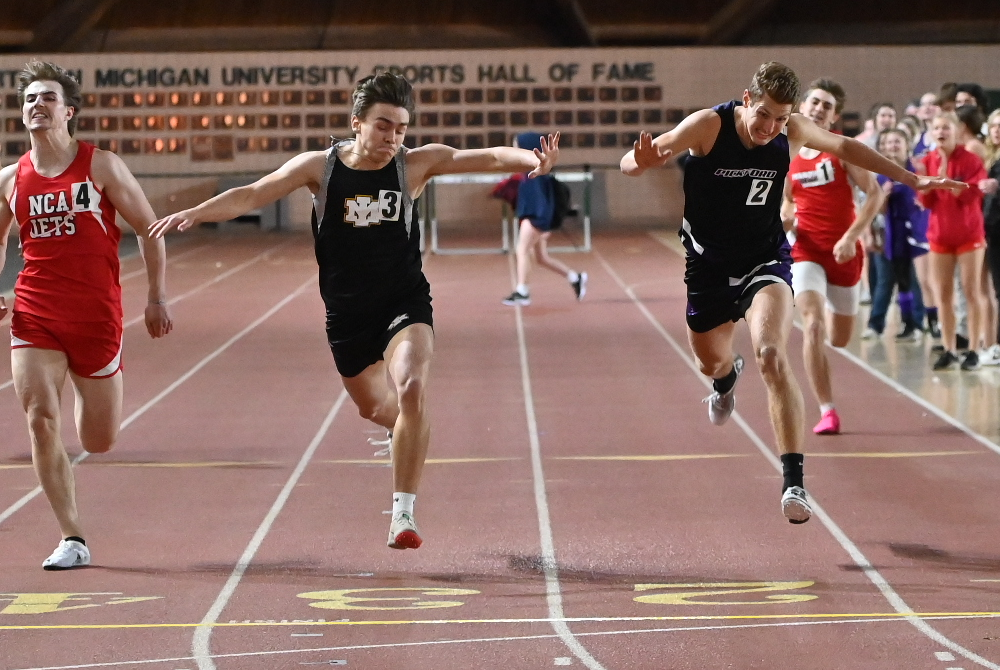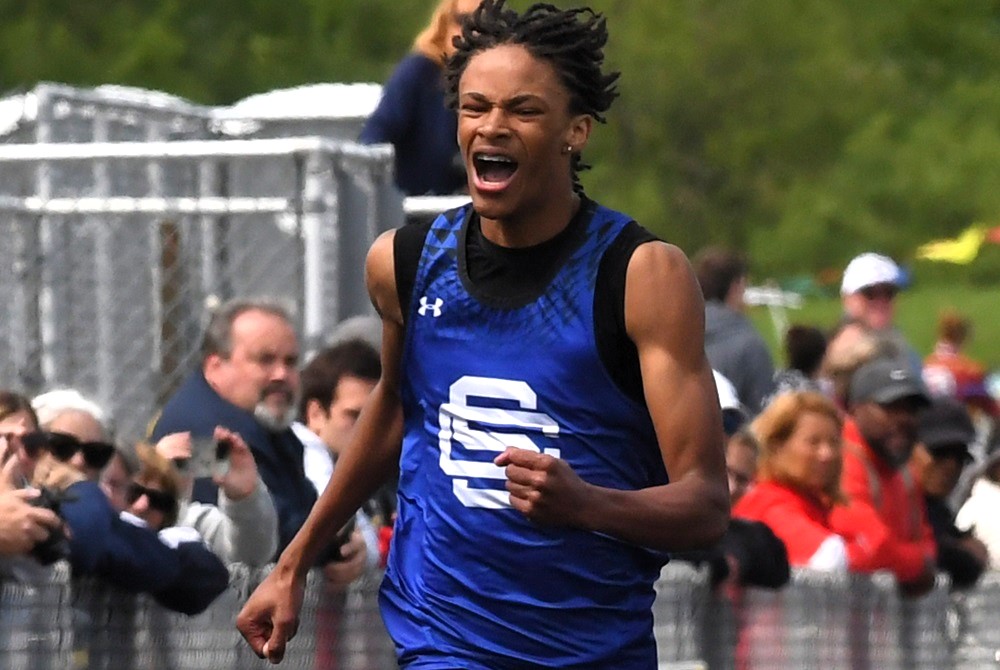
Preview: UP Boys Finals Loaded with Intriguing Opportunities
By
Geoff Kimmerly
MHSAA.com senior editor
June 2, 2023
Saturday’s Upper Peninsula Boys Track & Field Finals can match storylines with any of the other events happening statewide on the busiest day of the school sports season.
The Division 1 meet will pit rivals returning after one point separated them a year ago, while Division 2 will see a pair of 2022 champions looking to win again.
Munising’s Micaiah Peramaki will compete in his last Finals after becoming the latest to win four individual events last spring, and Pickford’s David Kozisek will compete in his first and only Finals with a great possibility of becoming the next four-event champ.
All three divisions will again be contested at Kingsford High School, with preliminaries leading off the day at 9 a.m. local (Central) time. Tickets cost $11 and are available digitally only via GoFan.
MHSAA.tv will live-stream the meets beginning at 9 a.m. (CDT)/10 a.m. (EDT), viewable with subscription.
Following is a glance at team contenders and individuals to watch in all three divisions:
Division 1
Team forecast: Marquette owns a two-year championship streak, but claimed last season’s title by a mere point ahead of Kingsford. The Flivvers will pose another challenge Saturday with a pair of relay favorites and strong field events hoping to counter Marquette’s distance stars and overall depth. Sault Ste. Marie, boasting excellence in the distance events as well, could factor significantly.
Matthew Colavecchi, Iron Mountain junior: Last season’s 100 and 200 champion in UPD2 will run on a contending 400 relay and had the sixth-fastest UPD1 Regional time in the 100 (11.85).
Will Fairchild, Iron Mountain senior: He finished fifth both in the 110 and 300 hurdles and eighth in long jump in UPD2 last season, but heads into these UPD1 Finals with the top Regional times for his division in both races – 16.05 and 42.48, respectively.
Michael Floriano, Kingsford junior: Last season’s 200 and 400 relay champion and 100 dash runner-up will run on two favored relays this time and also enters with the third-fastest UPD1 Regional times in the 100 (11.56) and 200 (23.94).
Drew Hughes, Gladstone senior: After running a relay at last year’s Finals, he’s set to run two plus enters with the top UPD1 Regional time in the 800 (2:05.23) and fourth-fastest in the 1,600 (4:38.46).
Gabe Litzner, Sault Ste. Marie freshman: The UPD1 cross country champion in the fall enters his first Track Finals with the top UPD1 Regional times in the 1,600 (4:35.42) and 3,200 (9:58.36).
Cole Myllyla, Kingsford senior: He’s another returning relay champ and also won the long jump and was sixth in the high jump last season. He’ll run on two favored relays and had the third-best UPD1 Regional long jump (20-¼).
Carson VanderSchaaf, Marquette senior: He’s a two-time 3,200 champion and also won the 1,600 and as part of the 3,200 relay last spring, and he’ll enter Saturday with the second-fastest UPD1 Regional time in the 1,600 (4:37.21) and third-fastest in the 3,200 (10:02.40).
Colin VanderSchaaf, Marquette senior: He’s also won races the last two Finals, the 800 last year and 1,600 as a sophomore (finishing second to his brother last year), and enters this meet with the second-fastest UPD1 Regional times in the 400 (54.11) and 800 (2:06.68) and third-fastest in the 1,600 (4:37.28).
Division 2
Team forecast: Ishpeming has four won straight Division 2 titles (not counting canceled 2020), but Pickford – last season’s UPD3 champion – might be the favorite to continue its streak instead. The Panthers have contenders in several events and also will get help with a number of Bark River-Harris hopefuls slotting into possible high places as well. That said, the Hematites do have qualifiers in 16 events and depth to match anyone in the field.
Caden Awbrey, Pickford senior: He won the 300 hurdles in UPD3 and was second in the 110 last season, also running on championship and runner-up relays. He’ll run on two contending relays this weekend and enters with the UPD2 Regionals third-fastest 300 time (43.97) and fourth-fastest in the 110 (17.63).
Wyatt Demers, Manistique junior: He had a busy 2022 Finals with a relay championship, fifth places in the 100 and 400 and a third in the 200. He could top that as part of two contending relays and entering with the fastest UPD2 Regional times in the 100 (11.5) and 200 (23.24).
Tramon Gauthier, Ishpeming junior: He played a major role in last year’s team title with a win in the 110 hurdles, second in the 300 and fourth-place long jump, and this weekend he enters with the second-best UPD2 Regional long jump (19-3), second-fastest 110 (16.41) and 300 hurdles (43.34) times and fourth-fastest in the 100 (11.99).
Hayden Hagen, Pickford junior: After also running on a relay champ last year in UPD3 and finishing fourth in the 3,200 and ninth in the 1,600, he’s lined up for a huge meet entering with the top UPD2 Regional times in the 800 (2:14.15), 1,600 (5:03.16) and 3,200 (11:08.89).
David Kozisek, Pickford senior: He could cap his lone season of high school track with one of the most memorable as he enters with the top UPD2 Regional times in the 110 (15.39) and 300 hurdles (42.37) and top high jump (5-10) and long jump (20-7½) as well.
Owen Lester, St. Ignace junior: The reigning pole vault champion (and seventh-place finisher in the 300 hurdles) posted the top UPD2 Regional pole vault (11-6) by six inches.
Brayden Martin, Ishpeming junior: He had the farthest UPD2 shot put (43-8½) and second-longest discus toss (119-2) at Regionals, after finishing fourth in the shot put at last year’s Finals.
Division 3
Team forecast: There will be a new champion with Pickford in UPD2, with 2022 runner-up Munising coming off a Regional title after falling just nine points shy of catching the Panthers a year ago. The Mustangs have favorites in several events and contenders in most others. Newberry, fifth in UPD2 last season, also looks capable of making serious noise.
Joe Kelley, Munising junior: He finished fifth in the 300 and sixth in the 110 hurdles last season, but could play a massive part Saturday entering with the fastest UPD3 Regional 300 (44.81) and second-fastest time in the 110 (17.06).
Kalvin Kytta, Chassell sophomore: He finished seventh in both the 1,600 and 3,200 and 10th in the 800 as a freshman and also will be expected to score entering with the fastest UPD3 Regional times in the 1,600 (4:48.91) and 3,200 (10:56.07).
Seth Mills, Paradise Whitefish senior: He could become his school’s first Finals champion in this sport as he enters with the top UPD3 Regional discus throw (149-4) by more than 21 feet – and with that toss nearly 40 better than his fifth-place finish in the event a year ago. He also enters with the sixth-best UPD3 Regional shot put (38-5).
Josiah Peramaki, Munising senior: The reigning pole vault champion also was third in the long jump and fifth in the 200 last season, and he’ll enter this weekend tied with the top UPD3 Regional pole vault (12-0) and also competing on a relay and in the long jump and 100, having posted the third-fastest time (11.73) in the sprint.
Micaiah Peramaki, Munising senior: He became the eighth boys four-time Finals individual champion last year winning the 100, 200, 400 and discus. He could add three more individual titles entering Saturday with UPD3 Regional bests in the 100 (11.24), 200 (23.47) and 400 (53.05) while also running on a contending relay.
Matthew Rahilly, Newberry sophomore: He was fifth in the long jump and ran on two scoring relays in UPD2 as a freshman, and enters this Finals with the best UPD3 Regional long jump (19-9) and tied for the second-best high jump (5-8).
Ian Sundling, Rapid River senior: The reigning long jump champ also finished seventh in high jump last season and will compete in both plus two relays, entering with the third-best UPD3 Regional long jump (19-1).
PHOTO Iron Mountain's Matthew Colavecchi (3) edges Pickford's David Kozisek (2) and Powers North Central's Luke Gorzinski (4) in a 200 heat at the April 17 Superior Dome Invitational. (Photo by Cara Kamps.)

Performance of the Week: Southfield Christian's Brock Morris
June 5, 2025
 Brock Morris ♦ Southfield Christian
Brock Morris ♦ Southfield Christian
Senior ♦ Track & Field
Morris finished an individually-phenomenal day at Saturday's Lower Peninsula Division 4 Finals by helping his teammates make school history. With Southfield Christian trailing leader Kalamazoo Hackett Catholic Prep by three points heading into the final event of the day, Morris anchored the Eagles' 1,600 relay and crossed the finish line first – which, combined with Hackett's third-place finish in the race, gave Morris and his teammates their school's first Finals team championship in track & field by one point.
That victory capped a day that also saw Morris win the 200 and 400-meter open races and run on the winning 800 relay as well. Morris was part of school records in all four of those races this season and the 400 relay as well; the 1,600 relay time of 3:24.36 on Saturday lowered that school record and also included Dylan Taylor-Wilkerson, Robert Brown and Jadon Staten. Morris also ran cross country and played point guard on the boys basketball team. He will study at University of Michigan, majoring in biology, health and society on a pre-medical track.
@mhsaasports 🏃♂️POW: Brock Morris #southfieldchristian #track #finals #winner #1600relay #anchor #part1 #highschoolsports #tiktalk #interview #performanceoftheweek #mistudentaid #fyp #MHSAA ♬ original sound - MHSAA
@mhsaasports 🏃♂️POW: Brock Morris #instagram #chocolatemilk #hidden #talent #emoji #part2 #performanceoftheweek #mistudentaid #fyp #MHSAA ♬ Monkeys Spinning Monkeys - Kevin MacLeod & Kevin The Monkey
Follow the MHSAA on TikTok.
MHSAA.com's "Performance of the Week" features are powered by MI Student Aid, a division within the Department of Lifelong Education, Advancement, and Potential (MiLEAP). MI Student Aid encourages students to pursue postsecondary education by providing access to student financial resources and information. MI Student Aid administers the state’s 529 college savings programs (MET/MESP), as well as scholarship and grant programs that help make college Accessible, Affordable and Attainable for you. Connect with MI Student Aid at www.michigan.gov/mistudentaid and find more information on Facebook and Twitter @mistudentaid.
Previous 2024-25 honorees
May 30: Chloe Qin, Bloomfield Hills Cranbrook Kingswood tennis - Report
May 23: Drew Goik, Bay City Western golf - Report
May 15: Sydney Kuhn, Saginaw Swan Valley track & field - Report
May 8: Ryan Bosch, Fruitport baseball - Report
May 1: Jackson Lam, Kalamazoo Loy Norrix track & field - Report
April 25: Isabelle Horvath, Bangor softball - Report
April 18: Presley Jones, Sterling Heights Stevenson soccer - Report
April 11: Olivia Jasniewicz, Troy soccer - Report
March 27: Katie Spicer, Fowler basketball - Report
March 21: Moses & Markus Blackwell; Warren Lincoln basketball - Report
March 13: Keyshawn Summerville, Lansing Sexton basketball - Report
March 6: Maggie Buurma, Fowlerville wrestling - Report
Feb. 28: Maren Studt, Pontiac Notre Dame Prep skiing - Report
Feb. 21: Olive Krueger, Marquette swimming - Report
Feb. 14: Hunter Lemmon, Fraser swimming - Report
Feb. 7: Aubrey Hillard, Rochester competitive cheer - Report
Jan. 31: Wyatt Spalo, Reed City wrestling - Report
Jan. 24: Olivia Flynn, Harbor Springs basketball - Report
Jan. 17: Levi Rozema, Holland Christian swimming - Report
Jan. 10: McRecco McFadden, Burton Bentley basketball - Report
Dec. 18: Nash Leonard, Bay City Western hockey - Report
Dec. 11: Blake Cosby, Dundee wrestling - Report
Dec. 4: Keaton Hendricks, Zeeland West football - Report
Nov. 29: Kate Simon, East Grand Rapids swimming - Report
Nov. 22: Ella Kokaly, Essexville Garber volleyball - Report
Nov. 15: Caroline Bryan, Grosse Pointe South swimming - Report
Nov. 8: Kaylie Livingston, Whitmore Lake cross country - Report
Oct. 25: Oliver Caldwell, Grand Rapids West Catholic tennis - Report
Oct. 18: Alex Graham, Detroit Cass Tech football - Report
Oct. 11: Victoria Garces, Midland Dow cross country - Report
Oct. 4: Asher Clark, Bay City John Glenn soccer - Report
Sept. 26: Campbell Flynn, Farmington Hills Mercy volleyball - Report
Sept. 19: TJ Hansen, Freeland cross country - Report
Sept. 12: Jordan Peters, Grayling soccer - Report
Sept. 6: Gabe Litzner, Sault Ste. Marie cross country - Report
Aug. 30: Grace Slocum, Traverse City St. Francis golf - Report
(Photo by RunMichigan.com.)

